Recent News
Longtail rescued from seaWednesday, July 22, 2015
Visitors help save baby longtail from drowning.
Scholarships for environment students
Saturday, July 18, 2015
Kahnae Bean and Shane Antonition have been awarded the 2015 Steinhoff/BZS Scholarship for students pursuing degrees in the environmental sciences.
Maya, 5, wins Zoo art competition
Tuesday, July 07, 2015
Five-year-old Maya Fitzmaurice Trott scooped top prize at the Bermuda Zoological Society’s Reef Watch art competition.
Setting Sail for the Sargasso Sea
Wednesday, July 01, 2015
The sailing research vessel Sea Dragon headed out to sea on Friday, June 5th to gather data on the Sargassum community around Bermuda, sponsored by the BAMZ support charities, the Atlantic Conservation Partnership and the Bermuda Zoological Society.
Preparing for Aqua Camp: It Takes a Village
Wednesday, July 01, 2015
While it would seem that after so many years of running Aqua Camp, it would be a walk in the park for those involved, it actually requires a great deal of time and planning to get ready for it each year. This includes ensuring that there are enough people involved to make sure it runs safely, as well as being fun and educational for each child that attends
About
GovernanceAbout Us
Newsletter
Latest News
Gift & Bookstore
Contact
General Inquiries
info@bzs.bm
Latest News
All the latest updates and news from the Bermuda Aquarium, Museum, and Zoo, one of Bermuda's leading visitor attractions!
Owain Johnston-Barnes
Published Feb 9, 2018 at 8:00 am (Updated Feb 9, 2018 at 8:03 am)
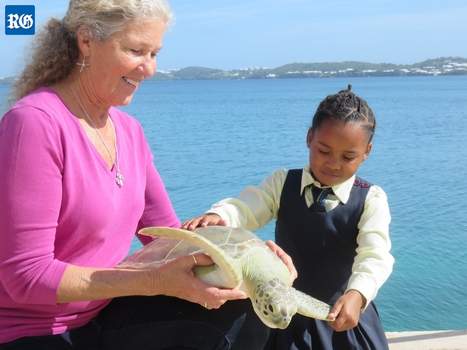
Jennifer Gray, director of the Bermuda Turtle Project, with Aerial Williams, 7,
and Bridget the turtle (Photograph by Owain Johnston-Barnes)
When Aerial Williams went fishing, a turtle was the last thing she expected to find at the end of her line.
The turtle, who she named Bridget, then had to go through surgery to remove a fish hook lodged deep in her gullet.
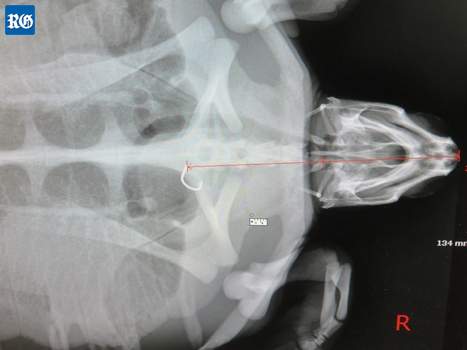
Turtle wound: an x-ray image showing the fish-hook caught in Bridget’s
oesophagus (Photograph by Owain Johnston-Barnes)
After months of rehabilitation at the Bermuda Aquarium, Museum and Zoo, Bridget is now ready to return to the sea.
Ian Walker, the aquarium’s veterinarian and principal curator, said: “These are special animals, and we need to take care of them.”
Bridget was caught during the Bermuda Tourism Authority’s Rediscover the Railway Trail event last October.
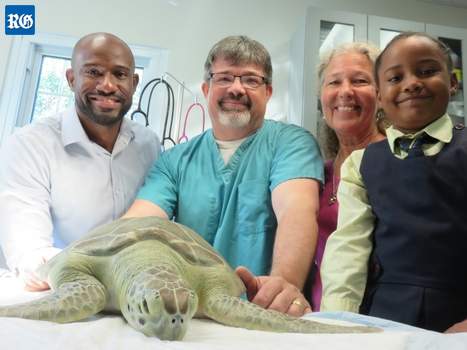
Glenn Jones of the Bermuda Tourism Authority, Ian Walker of the Bermuda Aquarium
Museum and Zoo, Jennifer Gray of the Bermuda Turtle Project and Aerial Williams
with Bridget the turtle (Photograph by Owain Johnston-Barnes)
Aerial and her family took part in the festivities, which included fishing off the rocks.
Aerial said: “I went to catch a fish, but then we caught something and we didn’t know what it was.
“I saw it put its head up and they said it was a turtle.”
Glenn Jones, director of public and stakeholder relations at the BTA, said the catch surprised everyone.
He said: “When Bridget was hooked, there were varying opinions about what we should do about it. I don’t think anybody knew exactly what we should do.
“Aerial’s mother got on the phone and ended up talking to the right person. We made the decision to drive the turtle here from Somerset with some instructions about how to keep it comfortable in the car.
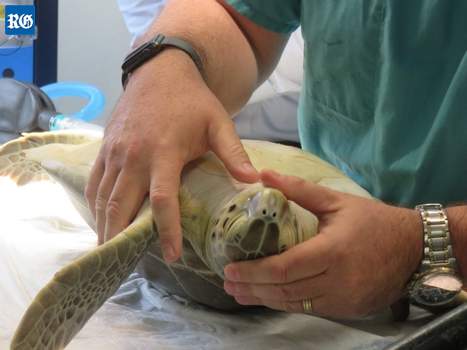
Ian Walker, veterinarian and curator at the Bermuda Aquarium Museum and Zoo,
performs a checkup on Bridget the turtle (Photograph by Owain Johnston-Barnes)
“I’m glad to see the turtle is doing so well now.”
Dr Walker said staff at the BAMZ were able to locate the hook with an X-ray and then remove it in an operation which lasted two hours.
He said: “We will tag the sea turtle, so if she comes in again we will know exactly who she is and what her medical history is.
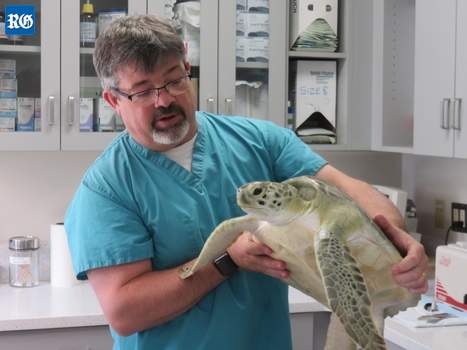
Ian Walker, veterinarian and curator at the Bermuda Aquarium Museum and Zoo,
performs a checkup on Bridget the turtle (Photograph by Owain Johnston-Barnes)
“There is nothing wrong with fishing. It’s great for Bermuda, but if you do get a sea turtle on the hook, you should call Rescue Co-ordination Centre Bermuda.
“We will come and collect the turtle or you could bring the turtle to us and we will take care of it from there.”
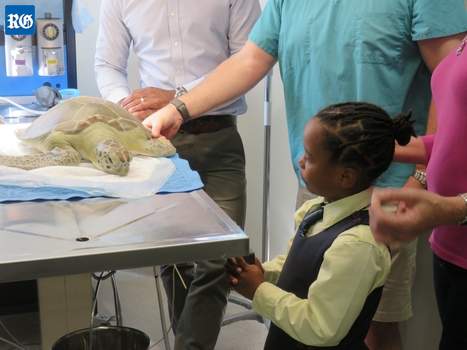
Aerial Williams looks on as Ian Walker, veterinarian and curator at the Bermuda
Aquarium Museum and Zoo, performs a checkup on Bridget the turtle
(photograph by Owain Johnston-Barnes)
Jennifer Gray, director of the Bermuda Turtle Project, said many people are unaware of what to do when they find an injured turtle.
Ms Gray also said that those who catch or find injured turtles should contact RCC Bermuda and get the turtle to the aquarium as soon as possible.
She added: “They are air-breathing animals. They can survive out of water. When you have a turtle that is sick or injured, sometimes the first instinct is to put them in water and, in actual fact, that’s the wrong thing to do.
“If they are ill or severely injured, they will beach themselves or come to the surface so they can get air, so you don’t want to put them in a bucket of sloshing water because they could drown.
“You need to make sure they don’t overheat in the sun. Put an umbrella over them or a cloth over them. You can use a wet cloth as long as it’s light.”
Ms Gray also said the public should not assume a turtle is dead as they can go into a coma-like state when sick or injured.
She said: “Even if you do find a dead turtle, valuable information can still be learnt. We want them dead or alive — just don’t kill them.”


